
Herbert Press An imprint of Bloomsbury Publishing Plc
| 50 Bedford Square | 1385 Broadway |
| London | New York |
| WC1B 3DP | NY 10018 |
| UK | USA |
www.bloomsbury.com This electronic edition published in 2017 by Bloomsbury Publishing Plc BLOOMSBURY and the Diana logo are trademarks of Bloomsbury Publishing Plc First published in Great Britain 2017 Bloomsbury Publishing plc Created for Bloomsbury by Plum5 Ltd Photographs and Illustrations Shutterstock All rights reserved
You may not copy, distribute, transmit, reproduce or otherwise make available this publication (or any part of it) in any form, or by any means (including without limitation electronic, digital, optical, mechanical, photocopying, printing, recording or otherwise), without the prior written permission of the publisher. Any person who does any unauthorised act in relation to this publication may be liable to criminal prosecution and civil claims for damages. No responsibility for loss caused to any individual or organization acting on or refraining from action as a result of the material in this publication can be accepted by Bloomsbury or the author. British Library Cataloguing-in-Publication Data A catalogue record for this book is available from the British Library. [Library of Congress Cataloguing-in-Publication data has been applied for.] ISBN: 978-1-9122-1704-5 (HB)
ISBN: 978-1-9122-1705-2 (eBook)
ISBN: 978-1-9122-1706-9 (ePDF) To find out more about our authors and their books please visit www.bloomsbury.com where you will find extracts, author interviews and details of forthcoming events, and to be the first to hear about latest releases and special offers, sign up for our newsletters.
Contents Introduction Sometimes revolution is a scary thing
 It brings to mind images of violence, dominant men and terrible fashion.
It brings to mind images of violence, dominant men and terrible fashion.
But luckily, you have stumbled on a beautiful revolution: The Craft Revolution. If you believe the internet, craftivism is a hot new craze sweeping the planet. Not your grandmothers protest! hollers the shouty clickbait. Happily this couldnt be further from the truth as craft and protest have been merrily cohabitating since your great, great, great grandmothers time. The Luddite, Suffragette, second wave feminist, and peace movements were amongst many to share a passion and understanding of the power handmade objects have to subversively communicate ideas. On January 21st 2017, 2.5 million people marched worldwide in the Womens March against Trump. The Womens March was a proactive international movement, galvanising people to defend womens rights, and those of others, in response to the rising rhetoric of far-right populism around the world.
Symbolic of this movement, hundreds of thousands of pink knitted pussy hats adorned the heads of marchers. More than simply casting off Trumps misogyny, the pussy hats empowered people to come together and creatively respond to politics. Friendships were made, solidarities forged, many debates were had. Most importantly, the mainstream came to realise that craft is not benign. Craft has the power to change minds, and a radical craft circle has the power to change the world. WELCOME TO THE REVOLUTION.
SAVING THE WORLD ONE STITCH AT A TIME. A short history The craft revolution  The craft revolution started a long time ago when people were resisting the Industrial Revolution. The People decided they had no interest in soulless objects made by soulless machines.
The craft revolution started a long time ago when people were resisting the Industrial Revolution. The People decided they had no interest in soulless objects made by soulless machines.
The People knew that there was an inherent greatness in stuff that was handmade by people in their own communities. They knew creativity within their community spilled over into all sorts of domains beyond craft itself. Imaginative people make better decisions. They create wonderful spaces in which to work, play and love. Imaginative people do not need to rely on violence to create a world they want to live in. However, the Industrial Revolution did get its way for a while.
Our communities have been successfully duped into believing we need to buy stuff to feel like proper human beings. Now that we are getting more and more disconnected from our communities and might get an empty feeling in our soul, we are taught that we can simply fill this void by buying more stuff. Stuff is no longer a wonderful, special part of our lives. Now stuff is disposable and unemotional; we have no idea where most of it comes from.  Thankfully a new craft revolution has been born. People all over the world are realising that buying things wont make you happier, sexier, brainier or better- looking.
Thankfully a new craft revolution has been born. People all over the world are realising that buying things wont make you happier, sexier, brainier or better- looking.
People are realising that the reason there is so much unhappiness and violence in our communities is because we have become so disconnected from the land, our friends and family, and most of all from the processes that are needed to make this world function. THE PEOPLE ARE RETURNING TO THE EARTH AND HEARING WHAT SHE HAS TO SAY. The basics What you need to know FABRIC The most common material used for cross stitch is known as Aida cloth. It has a special weave to make sure the holes in the fabric are evenly spaced so your stitches stay nice and square and even. Aida cloth comes in different counts that indicate the number of threads per inch. Most cross stitch is completed on 14 count Aida, as are the patterns in this book. You can use a different count fabric, but make sure you do a little sample to see whether you need to use more or less strands of thread when you stitch.
Some people like to clean, dry and iron their fabric before use. If it has fold creases in it, thats a pretty important step. However if your fabric is brand new and free of folds, thats not really necessary. EMBROIDERY HOOPS Embroidery hoops arent essential to use, but they do make life a lot easier and will help keep your fabric tension nice and tight. There are already millions in the world so if you dont have one, check the craft supplies at your local thrift shop before you go buying a new hoop. You can get hoops that double as round hanging frames.
If you decide to use one of these, make sure your fabric tension is very square and even before you start stitching. Make sure you keep your hands and working area clean so you dont have to wash the fabric again when you finish.  To use, simply lay your fabric between the two rings of the hoop and tighten the screw to bring tension to your fabric. Its best if you can use a hoop that is a little bigger than your project area so you dont have to keep moving it around and squashing your stitches.
To use, simply lay your fabric between the two rings of the hoop and tighten the screw to bring tension to your fabric. Its best if you can use a hoop that is a little bigger than your project area so you dont have to keep moving it around and squashing your stitches.  NEEDLES There are all sorts of needles out there and cross stitch has its own special type. Cross stitch needles are thin, with a blunt end and a long thread hole.
NEEDLES There are all sorts of needles out there and cross stitch has its own special type. Cross stitch needles are thin, with a blunt end and a long thread hole.



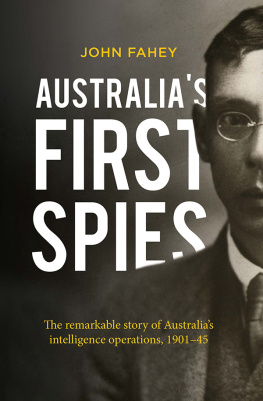
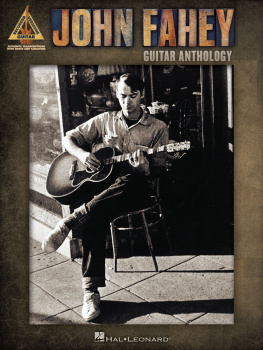
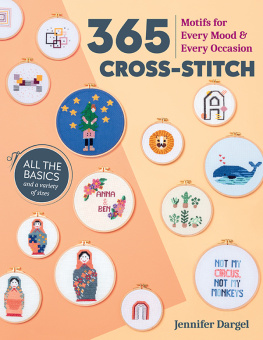

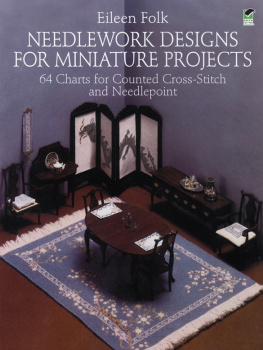


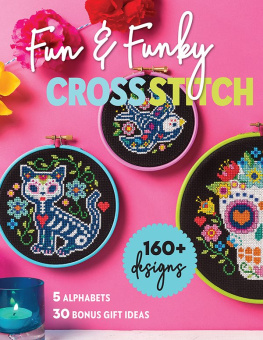


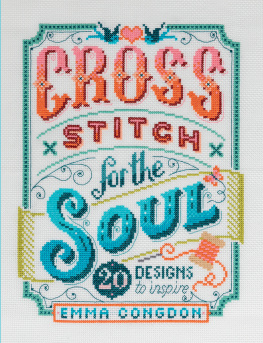
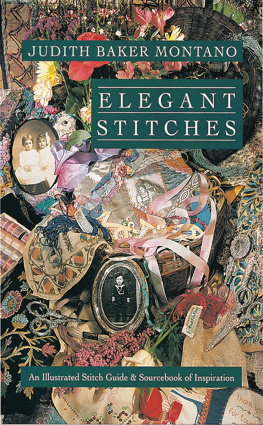
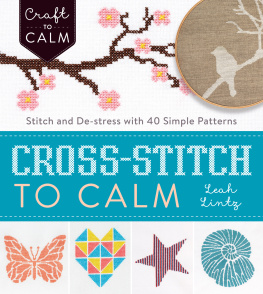


 Herbert Press An imprint of Bloomsbury Publishing Plc
Herbert Press An imprint of Bloomsbury Publishing Plc  It brings to mind images of violence, dominant men and terrible fashion.
It brings to mind images of violence, dominant men and terrible fashion. The craft revolution started a long time ago when people were resisting the Industrial Revolution. The People decided they had no interest in soulless objects made by soulless machines.
The craft revolution started a long time ago when people were resisting the Industrial Revolution. The People decided they had no interest in soulless objects made by soulless machines. Thankfully a new craft revolution has been born. People all over the world are realising that buying things wont make you happier, sexier, brainier or better- looking.
Thankfully a new craft revolution has been born. People all over the world are realising that buying things wont make you happier, sexier, brainier or better- looking. To use, simply lay your fabric between the two rings of the hoop and tighten the screw to bring tension to your fabric. Its best if you can use a hoop that is a little bigger than your project area so you dont have to keep moving it around and squashing your stitches.
To use, simply lay your fabric between the two rings of the hoop and tighten the screw to bring tension to your fabric. Its best if you can use a hoop that is a little bigger than your project area so you dont have to keep moving it around and squashing your stitches.  NEEDLES There are all sorts of needles out there and cross stitch has its own special type. Cross stitch needles are thin, with a blunt end and a long thread hole.
NEEDLES There are all sorts of needles out there and cross stitch has its own special type. Cross stitch needles are thin, with a blunt end and a long thread hole.